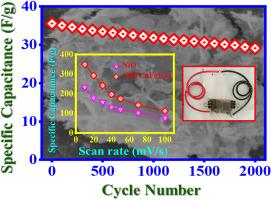在NiO纳米片上修饰CuFe2O4粒子用于高性能半固态超级电容器
IF 3.5
3区 化学
Q2 CHEMISTRY, INORGANIC & NUCLEAR
引用次数: 0
摘要
过渡金属氧化物和铁氧体基纳米结构已成为储能系统,特别是超级电容器中电极材料的理想候选者。这主要是由于它们独特的优势组合,包括卓越的电化学稳定性、高效的混合离子-电子导电性、成本效益和生态友好性。这些特点使它们非常适合可持续能源技术。本研究采用一步水热法制备了CuFe2O4/NiO复合材料。电化学研究表明,CuFe2O4/NiO复合材料具有出色的电荷存储能力,在电流密度为1 a /g时,其比电容(Csp)高达~ 348 F/g。该电极的能量密度(ED)为20.25 Wh/kg,对应的功率密度(PD)为565 W/kg,突出了其具有良好的储能能力。这种增强的电化学响应归因于CuFe2O4和NiO相之间的协同效应。这种协同作用不仅提高了导电性,而且还赋予了磁响应性,这可能为功能设备集成提供额外的好处。总的来说,这些发现突出了CuFe2O4/NiO纳米复合材料作为下一代电化学能源应用的合适材料的潜力,特别是在SC技术中。本文章由计算机程序翻译,如有差异,请以英文原文为准。

CuFe2O4 particles decorated on NiO nanosheets for high performance semi-solid supercapacitor
Transition metal oxides and ferrite-based nanostructures have emerged as desirable candidates for electrode materials in energy storage systems, particularly supercapacitors. This is primarily due to their unique combination of advantageous properties, including superior electrochemical stability, efficient mixed ionic-electronic conductivity, cost-effectiveness, and eco-friendliness. These features make them well-suited for sustainable energy technologies. In the current study, a CuFe2O4/NiO composite was successfully prepared using a one-step hydrothermal method. The electrochemical studies revealed outstanding charge storage capability, with the CuFe2O4/NiO composite delivering a high specific capacitance (Csp) of ∼348 F/g at a current density of 1 A/g. The electrode delivered an energy density (ED) of 20.25 Wh/kg with a corresponding power density (PD) of 565 W/kg, highlighting its promising capability for energy storage. This enhanced electrochemical response is attributed to the cooperative effect between the CuFe2O4 and NiO phases. This synergy not only improves the electrical conductivity but also imparts magnetic responsiveness, which may offer additional benefits in functional device integration. Overall, these findings highlight the potential of CuFe2O4/NiO nanocomposites as suitable materials for next-generation electrochemical energy applications, especially in SC technologies.
求助全文
通过发布文献求助,成功后即可免费获取论文全文。
去求助
来源期刊

Journal of Solid State Chemistry
化学-无机化学与核化学
CiteScore
6.00
自引率
9.10%
发文量
848
审稿时长
25 days
期刊介绍:
Covering major developments in the field of solid state chemistry and related areas such as ceramics and amorphous materials, the Journal of Solid State Chemistry features studies of chemical, structural, thermodynamic, electronic, magnetic, and optical properties and processes in solids.
 求助内容:
求助内容: 应助结果提醒方式:
应助结果提醒方式:


